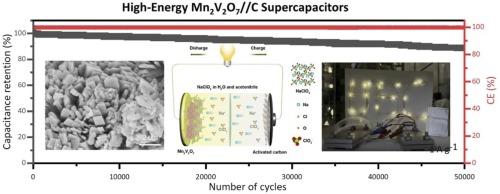当前位置:
X-MOL 学术
›
Nano Energy
›
论文详情
Our official English website, www.x-mol.net, welcomes your
feedback! (Note: you will need to create a separate account there.)
High-energy Mn2V2O7//C asymmetric supercapacitors in aqueous/organic hybrid electrolytes
Nano Energy ( IF 16.8 ) Pub Date : 2024-11-03 , DOI: 10.1016/j.nanoen.2024.110446 Rameez Ahmad Mir, Jia Xu, Li Tao, Evan J. Hansen, Ali Khosrozadeh, Mitchell B. Miller, Jian Liu
Nano Energy ( IF 16.8 ) Pub Date : 2024-11-03 , DOI: 10.1016/j.nanoen.2024.110446 Rameez Ahmad Mir, Jia Xu, Li Tao, Evan J. Hansen, Ali Khosrozadeh, Mitchell B. Miller, Jian Liu

|
The demand for advanced energy storage devices, such as high-energy density supercapacitors, has spurred efforts to develop new environmentally friendly and efficient electrode materials and electrolyte solutions for sustainable development. A prominent strategy is the fabrication of high-voltage and energy-density asymmetric supercapacitors (AS). In this study, dimanganese divanadate (Mn2 V2 O7 , MVO) particles were synthesized via a hydrothermal process and used as pseudocapacitive electrodes for AS. The pseudocapacitive MVO electrode offered synergistic advantages of reversible surface or near-surface Faradaic reactions for charge storage. Another approach to address the challenges of limited energy density in supercapacitors was modifying the electrolyte solution to widen the operating voltage window and increase energy density. A hybrid electrolyte solution of 5 M sodium perchlorate (NaClO4 ) in a mixture of (2:1) volume ratio of acetonitrile (AN) and water (H2 O) was introduced to expand the voltage window in the AS. The fabricated AS with MVO as a pseudocapacitive electrode and activated carbon as a double-layer capacitive electrode operated in a voltage window > 2.0 V with the hybrid electrolyte. The AS device exhibited a capacitance of 156.9 F g−1 at 0.1 A g−1 and a high energy density of 87.2 Wh kg−1 , surpassing the carbon-based symmetric supercapacitor (58.9 Wh kg−1 ). Furthermore, the pseudocapacitive supercapacitor showed exceptional long-term stability over 50,000 cycles. Structural and surface characterization of the MVO electrode after CV testing validated that the charge storage mechanism in Mn2 V2 O7 //C was a surface-controlled process. The performance of the AS pouch cell revealed the great promise of the pseudocapacitive electrode in practical applications.
中文翻译:

水系/有机混合电解质中的高能 Mn2V2O7//C 非对称超级电容器
对高能量密度超级电容器等先进储能器件的需求促使人们努力开发新型环保高效的电极材料和电解质解决方案,以实现可持续发展。一个突出的策略是制造高电压和能量密度的非对称超级电容器 (AS)。在本研究中,通过水热工艺合成了二锰二酸锰 (Mn2V2O7, MVO) 颗粒,并用作 AS 的伪电容电极。伪电容式 MVO 电极为电荷存储提供了可逆表面或近表面法拉第反应的协同优势。解决超级电容器能量密度受限挑战的另一种方法是修改电解质溶液,以扩大工作电压窗口并提高能量密度。引入 5 M 高氯酸钠 (NaClO4) 与乙腈 (AN) 和水 (H2O) 体积比 (2:1) 的混合物中的混合电解质溶液,以扩大 AS 中的电压窗口。以 MVO 作为伪电容电极和活性炭作为双层电容电极的制造的 AS,在电压窗口 > 2.0 V 中与混合电解质一起工作。AS 器件在 0.1 A g-1 时表现出 156.9 F g-1 的电容和 87.2 Wh kg-1 的高能量密度,超过了碳基对称超级电容器 (58.9 Wh kg-1)。此外,伪电容超级电容器在 50,000 次循环中表现出卓越的长期稳定性。CV 测试后 MVO 电极的结构和表面表征证实了 Mn2V2O7//C 中的电荷存储机制是一个表面控制过程。AS 软包电池的性能揭示了伪电容电极在实际应用中的巨大前景。
更新日期:2024-11-03
中文翻译:

水系/有机混合电解质中的高能 Mn2V2O7//C 非对称超级电容器
对高能量密度超级电容器等先进储能器件的需求促使人们努力开发新型环保高效的电极材料和电解质解决方案,以实现可持续发展。一个突出的策略是制造高电压和能量密度的非对称超级电容器 (AS)。在本研究中,通过水热工艺合成了二锰二酸锰 (Mn2V2O7, MVO) 颗粒,并用作 AS 的伪电容电极。伪电容式 MVO 电极为电荷存储提供了可逆表面或近表面法拉第反应的协同优势。解决超级电容器能量密度受限挑战的另一种方法是修改电解质溶液,以扩大工作电压窗口并提高能量密度。引入 5 M 高氯酸钠 (NaClO4) 与乙腈 (AN) 和水 (H2O) 体积比 (2:1) 的混合物中的混合电解质溶液,以扩大 AS 中的电压窗口。以 MVO 作为伪电容电极和活性炭作为双层电容电极的制造的 AS,在电压窗口 > 2.0 V 中与混合电解质一起工作。AS 器件在 0.1 A g-1 时表现出 156.9 F g-1 的电容和 87.2 Wh kg-1 的高能量密度,超过了碳基对称超级电容器 (58.9 Wh kg-1)。此外,伪电容超级电容器在 50,000 次循环中表现出卓越的长期稳定性。CV 测试后 MVO 电极的结构和表面表征证实了 Mn2V2O7//C 中的电荷存储机制是一个表面控制过程。AS 软包电池的性能揭示了伪电容电极在实际应用中的巨大前景。

































 京公网安备 11010802027423号
京公网安备 11010802027423号